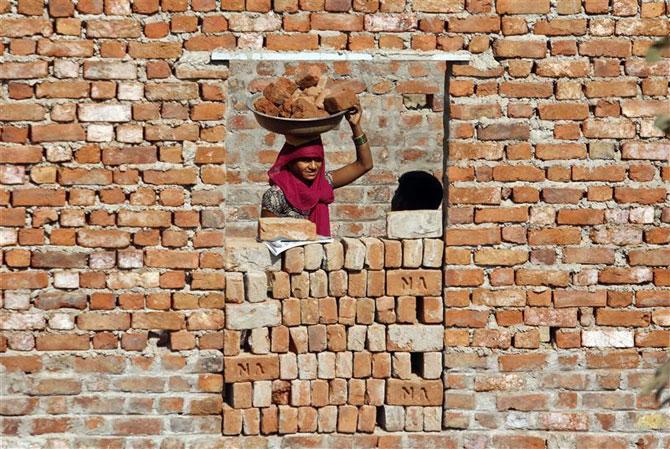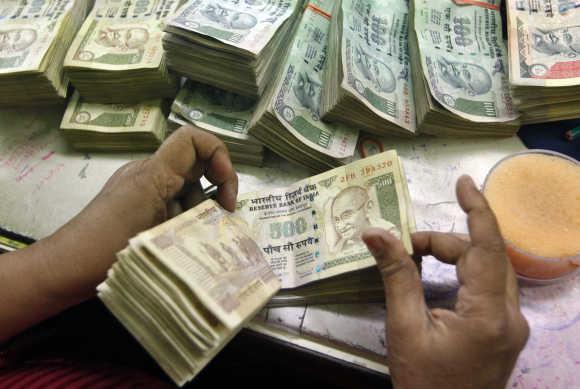Photographs: Munish Sharma/Reuters Sajjid Chinoy
The strong monsoon and record harvest will boost rural demand, already evidenced in strong tractor and two-wheeler sales, says Sajjid Chinoy.
Over the last few months, the Indian economy has been on nothing short of a roller-coaster ride.
There was premature euphoria in April on the beneficial impact of plunging gold and oil prices on India’s twin deficits.
This turned into shock and horror in May when the US Fed sneezed and India caught the flu. The rupee went into a free fall and markets obsessed on India’s twin deficits. India could do no right.
Three months later, the interest rate defence has been unwound, growth is expected to re-accelerate, the current account deficit (CAD) is on course for a dramatic narrowing, and suddenly equity markets are at three-year highs. But inflation pressures are re-accelerating.
What are we to make of these developments? How much of this is on account of improved sentiment vis-a-vis fundamentals? How much is cyclical vis-à-vis structural?
To what extent have imbalances narrowed simply because growth remains weak. Put differently, will a growth pick-up reignite current account and inflation pressures? This piece attempts to make sense of these issues.
The change in macroeconomic conditions between the monsoon and winter is epitomised best in the exchange rate. The free fall of the rupee in August was both a cause and a symptom of prevailing macro uncertainty.
...
Is the worst over for the Indian economy?
Photographs: Amit Dave/Reuters
Not only did it reflect the perils of funding a bloated current account through fickle portfolio flows, but revealed how fragile sentiment can be, and the extent to which expectations can get unhinged.
Then the currency overshooting, itself, was the source of more macro angst, risking much higher inflation, serious fiscal slippage, and further pressurising fragile corporate balance sheets with un-hedged dollar liabilities. India got stuck in a vicious cycle.
Much has changed since then. The rupee has mean-reverted smartly towards its fair value and been relatively stable. To be sure, it is still one of the worst performing emerging market currencies, having depreciated nearly 15 per cent since May, but arguably this is a necessary adjustment to offset high inflation and restore competitiveness.
The relative stability of the rupee is more impressive when you consider that a chunk of oil demand is back in the market without market participants realising - revealing how artfully policymakers acted.
But has the rupee stabilised simply because the taper was postponed or because external imbalances have narrowed? While a multitude of factors have helped, the narrowing of the CAD is key.
...
Is the worst over for the Indian economy?
Photographs: Reuters
The CAD that printed at nearly 5 per cent of gross domestic product (GDP) last year will print below 3 per cent of GDP this year. In fact, it’s possible the current account temporarily turned into surplus last quarter. How did this happen?
Firming global growth along with the 10-per cent real depreciation of the currency have boosted goods and services exports. Information technology, textiles, engineering goods exports are booming. This is unambiguously good.
Second, gold imports have collapsed in response to the government’s war on gold. This definitely buys policymakers time. But if the underlying drivers of the demand for gold (high inflation, negative real rates of return on financial assets) are not addressed, gold will simply move to a parallel market. Gold imports will be replaced by higher errors and omissions in the balance of payments.
Third, the CAD has narrowed because of continued weakness of non-oil, non-gold imports. Part of this is because of the rupee depreciation, but a large part is because India’s growth has slowed sharply over the last two years. In other words, the CAD is lower precisely because India’s growth differential vis-a-vis its trading partners has narrowed so much.
...
Is the worst over for the Indian economy?
Photographs: Reuters
So, any pick-up in growth is likely to pressure imports and, therefore, the CAD. India’s challenge is to maintain a 3 per cent CAD when growth is at 6 per cent, not 4 per cent.
For this to happen, the structural rise in coal, scrap metal and fertiliser imports and disappearing iron ore exports need to be addressed. Relief, not celebration, should accompany a lower CAD.
The same is true of the fiscal deficit. The government should be commended for the sustained increase in diesel prices and sticking to the budgeted deficit despite weak growth, and it being an election year. Finally, a sense of sanctity has returned to Budget targets.
But repeatedly slashing plan expenditures and running up arrears cannot be a sustainable strategy for deficit reduction.
Instead, adoption of the long overdue goods and services tax and bringing major subsidies (food, fuel) under the Unique Identification Number’s ambit – so that substantial de-duplication gains can be realised – is critical for future fiscal consolidation.
That said, a pick up in growth would certainly help the fisc.
So is the worst over on growth? Are we on the cusp of a sustained and meaningful acceleration? To be sure, the strong monsoon and record harvest will boost rural demand, already evidenced in strong tractor and two-wheeler sales. And this is being complemented by strong export growth.
...
Is the worst over for the Indian economy?
Photographs: Reuters
But its too early to uncork the champagne. For the government to meet its deficit target, significant expenditure compression will be required in the coming four months that will be a meaningful drag on growth.
Additionally, elevated retail inflation is likely to squeeze urban consumption, and there are no signs of any investment pick-up. Any acceleration, therefore, is likely to be more modest than presumed.
But if growth is so weak why is core inflation sticky and rising? In economist jargon, why is core inflation accelerating when output gaps are negative ? Core consumer price index has been stuck in the 7-8 per cent range for the last year and the sequential, annualised momentum of core wholesale price index is back up above 6 per cent. How do we reconcile this?
The reconciliation is not difficult if one considers the microeconomics of the corporate sector. Sustained input price increases over the last 18 months against the backdrop of slowing demand, has meant that corporate India has had to suffer sharp margin compressions.
Against this backdrop, the 15-per cent depreciation of the rupee has further pushed up input costs and is forcing corporations to raise output prices. Good for corporate profitability, but not so good for core inflation.
...
Is the worst over for the Indian economy?
Photographs: Reuters
Why does this matter? Because if growth and demand pick up – corporations are likely to opportunistically raise prices and restore margins – and higher growth could, therefore, be accompanied by higher core inflation.
So what would it take to avoid a trade-off between macroeconomic stability and growth? Quite simply, a pick-up in private investment. It was surging corporate investment growth that led to 9 per cent growth in the 2000s. And the resulting capacity creation meant that both the current account and inflation pressures were contained.
The government recognises this and, to their credit, has cleared more than 4 per cent of GDP in stalled projects in the last six months. Yet, project execution may well have to wait until corporate debt overhang plays itself out and political uncertainty from elections is resolved.
Policymakers deserve credit on a variety of fronts over the last few months - reining in rupee expectations, chipping away at diesel prices and expediting project approvals. But it’s only when investment picks up decisively will growth, inflation and the current account not be in necessary conflict.
The author is chief India economist, JP Morgan.








article